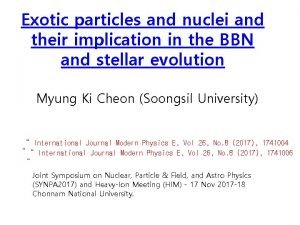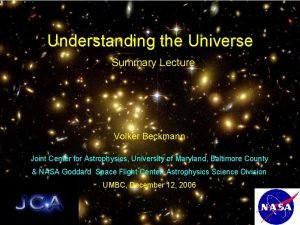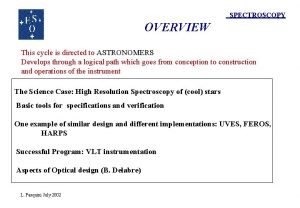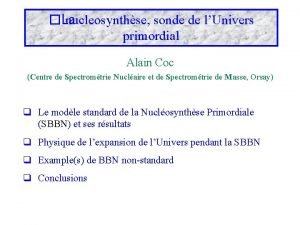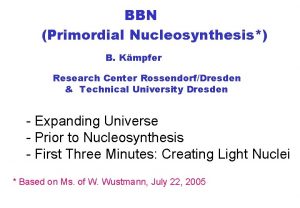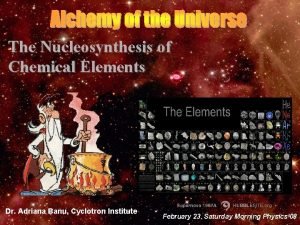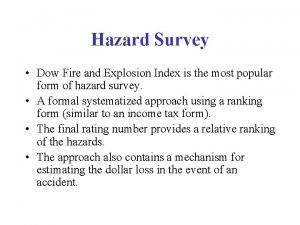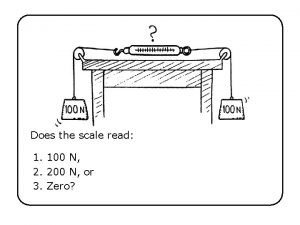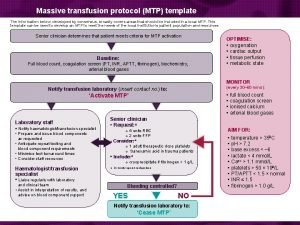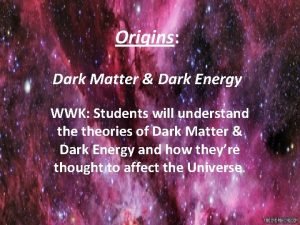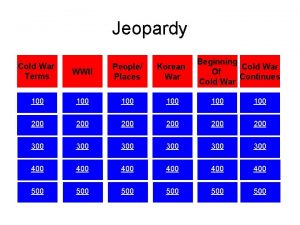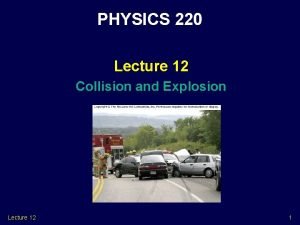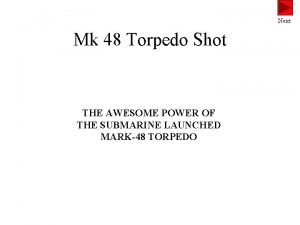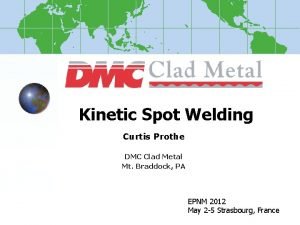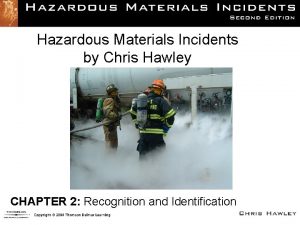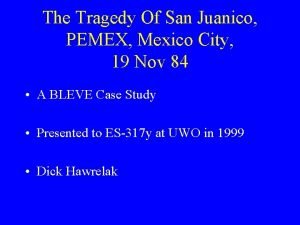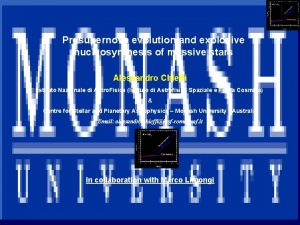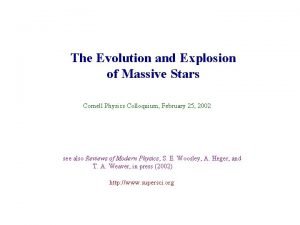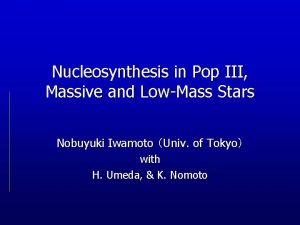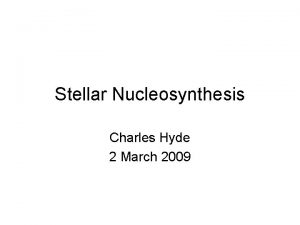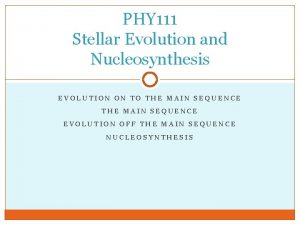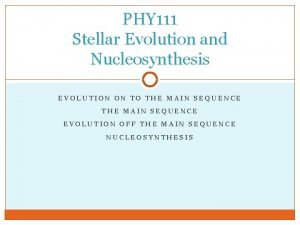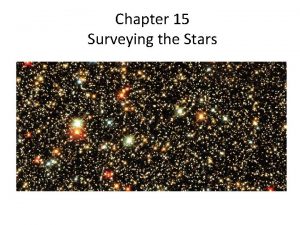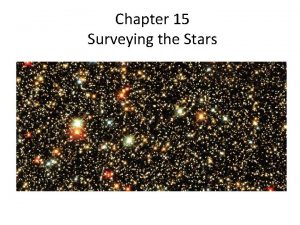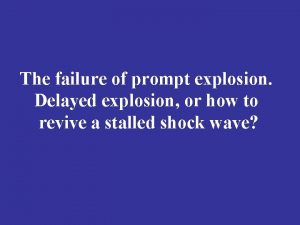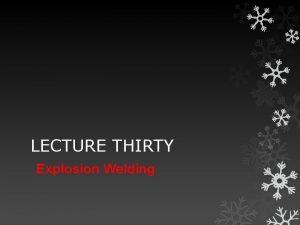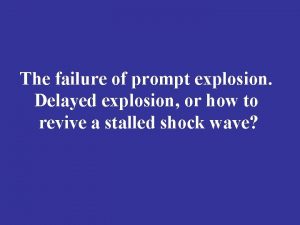MASSIVE STARS PRESUPERNOVA EVOLUTION EXPLOSION AND NUCLEOSYNTHESIS Marco



























































- Slides: 59

MASSIVE STARS: PRESUPERNOVA EVOLUTION, EXPLOSION AND NUCLEOSYNTHESIS Marco Limongi INAF – Osservatorio Astronomico di Roma, ITALY and Centre for Stellar and Planetary Astrophysics Monash University – AUSTRALIA Email: marco@oa-roma. inaf. it

What is a Massive star ? It is a star that goes through all the hydrostatic burnings in a quiescent way from H to Si and eventually explodes as a core collapse supernova Mup’ 8 - 10 < Massive stars < MPISN >120

Why are Massive stars important in the global evolution of our Universe? Light up regions of stellar birth induce star formation Production of most of the elements (those necessary to life) Mixing (winds and radiation) of the ISM Production of neutron stars and black holes Cosmology (Pop. III): Reionization of the Universe at z>5 Massive Remnants (Black Holes) AGN progenitors Pregalactic Chemical Enrichment High Energy Astrophysics: Production of long-lived radioactive isotopes: (26 Al, 56 Co, 57 Co, 44 Ti, 60 Fe) GRB progenitors The understanding of these stars, is crucial for the interpretation of many astrophysical objects

BB = Big Bang; CR = Cosmic Rays; neut. = n induced reactions in SNII; IMS = Intermediate Mass Stars; SNII = Core collapse supernovae; SNIa = Termonuclear supernovae; s-r = slow-rapid neutron captures Le SNII contribuiscono in maniera rilevante all’evoluzione chimica della Galassia. Responsabili per la nucleosintesi degli elementi con 16<A<50 and 60<A<90

Computation of the Presupernova Evolution of Massive Stars 60 Zn 61 Zn 62 Zn 63 Zn 64 Zn 65 Zn 66 Zn 67 Zn 68 Zn 57 Cu 58 Cu 59 Cu 60 Cu 61 Cu 62 Cu 63 Cu 64 Cu 65 Cu 66 Cu 67 Cu 56 Ni 1. Extended Network 57 Ni 58 Ni 59 Ni 60 Ni 61 Ni 62 Ni 63 Ni 64 Ni 65 Ni 54 Co 55 Co 56 Co 57 Co 58 Co 59 Co 60 Co 61 Co 62 Co 52 Fe Including a large number of isotopes and reactions (captures of light partcles, e± captures, β± decays) 53 Fe 54 Fe 55 Fe 56 Fe 57 Fe 58 Fe 59 Fe 60 Fe 61 Fe 51 Mn 52 Mn 53 Mn 54 Mn 55 Mn 56 Mn 57 Mn 48 Cr 49 Cr 50 Cr 51 Cr 52 Cr 53 Cr 54 Cr 55 Cr 41 Sc 42 Sc 45 V 46 V 47 V 48 V 49 V 50 V 51 V 52 V 44 Ti 45 Ti 46 Ti 47 Ti 48 Ti 49 Ti 50 Ti 51 Ti 43 Sc 44 Sc 45 Sc 46 Sc 47 Sc 48 Sc 49 Sc 50 Sc 40 Ca 41 Ca 42 Ca 43 Ca 44 Ca 45 Ca 46 Ca 47 Ca 48 Ca 49 Ca 37 K 38 K 39 K 40 K 41 K 42 K 35 Ar 36 Ar 37 Ar 38 Ar 39 Ar 40 Ar 41 Ar 1 H 3 He 4 He 2 H 3 H 25 Al 33 Cl 34 Cl 35 Cl 36 Cl 37 Cl 38 Cl 31 S 32 S 33 S 34 S 35 S 36 S 37 S 29 P 30 P 31 P 32 P 33 P 34 P 27 Si 28 Si 29 Si 30 Si 31 Si 32 Si 33 Si 26 Al 27 Al 28 Al (a, n) (a, g) 23 Mg 24 Mg 25 Mg 26 Mg 27 Mg n 21 Na 22 Na 23 Na 24 Na (p, n) b-, e+ 20 Ne 21 Ne 22 Ne 23 Ne 7 Be 8 Be 6 Li 7 Li 17 F 18 F 19 F 20 F 15 O 16 O 17 O 18 O 19 O 13 N 14 N 15 N 16 N 12 C 13 C 14 C 10 B 11 B 9 Be 10 Be (p, g) (n, g) (g, n) (g, p) (p, a) (g, a) (n, a) (a, p) b+, e(n, p)

Computation of the Presupernova Evolution of Massive Stars 2. Strong coupling between physical and chemical evolution: + H/He burnings: Decoupled Adv. burnings: Coupled

Computation of the Presupernova Evolution of Massive Stars 3. Tratment of convection: - Time dependent convection - Interaction between Mixing and Local Burning D = Diffusion Coefficient

Convective Core H burning g CNO Cycle g g g Massive Stars powered by the CNO Cycle The Convective Core shrinks in mass

CNO Cycle 12 C + 1 H 13 N + g 13 N 13 C + e+ + n 13 C + 1 H 14 N + g 14 N + 1 H 15 O + g 15 O 15 N CN-Cycle 15 N + e+ + n + 1 H 12 C + 4 He (99%) 16 O + g (1%) (T 3× 107 K) 16 O + 1 H 17 F + g 17 F 17 O + e+ + n NO-Cycle + 1 H 14 N + 4 He CNO Processed Material C N O

Ne-Na and Mg-Al Cycles During Core H Burning the central temperature is high enough (3 -7× 107 K) that the Ne-Na and Mg-Al cycles become efficient Ne-Na Cycle 20 Ne + 1 H 21 Na + g 21 Na 21 Ne Mg-Al Cycle 21 Ne + e+ + n + 1 H 22 Na + g 22 Na + 1 H 25 Al + g 24 Mg 25 Al + 1 H 26 Al + g 25 Mg 22 Ne + e+ + n 26 Al 22 Ne + 1 H 23 Na + g 26 Mg 23 Na + 1 H 20 Ne + 4 He 27 Al 25 Mg + e+ + n 26 Mg + e+ + n + 1 H 27 Al + g + 1 H 24 Mg + 4 He Ø 21 Na e 25 Mg destroyed Ø 22 Ne slightly burnt Ø 23 Na e 26 Mg increases Ø 26 Al (~10 -7) produced

Evolutionary Properties of the Interior t=6. 8 106 yr

Evolutionary Properties of the Surface Core H Burning Models Mmin(O) = 14 M t(O)/t(H burning): 0. 15 (14 M ) – 0. 79 (120 M )

Major Uncertainties in the computation of core H burning models: Extension of the Convective Core (Overshooting, Semiconvection) Mass Loss Both influences the size of the He core that drives the following evolution

Core He burning 3 a+ 12 C(a, g)16 O 4 He g g g He Convective Core 8 Be 8 Be g g g 4 He + 4 He 12 C + g 3 4 He 12 C + g g g + 4 He 8 Be + g rad He C, O Bordo iniziale CC Mix He ad Core Convettivo H burning shell H exhausted core (He Core) The He convective core increases in mass

Nucleosynthesis during Core He burning 3 4 He 12 C + g 12 C + 4 He 12 O + g 16 O + 4 He 20 Ne + g 20 Ne + 4 He 24 Mg + g Chemical composition at core He exhaustion: mainly C/O The C/O ratio is one the quantity that mainl affects the advanced evolution of Massive Stars (it determines the composition of the CO core) C/O ratio depends on: 1. Treatment of convection (late stages of core He burning) 2. 12 C(a, g)16 O cross section

Nucleosynthesis during Core He burning 14 N, produced by H burning activates the sequence of reactions: 14 N + 4 He 18 F + g 18 F 18 O + e+ + n + 4 He 22 Ne + g 22 Ne + 4 He 25 Mg + n For the CNO cycle: For e Solar composition XCNO(iniziale) X 14 N For a Solat composition at core H exhaustion: X(14 N) ~ ½ Z In general: The efficiency of the 14 N reactions scales with the metallicity

Nucleosynthesis during Core He burning 14 N 22 Ne during the initial stages of core He burning H burning CNO (~1/2 Z) 14 N (~1/2 Z) 22 Ne (~Z) During core He burning, 22 Ne is reduced by a factor of ~2 by the nuclear reaction: 22 Ne + 4 He 25 Mg + n Neutron Mass Fraction s-process nucleosynthesis

s-process during Core He burning p 78 Rb 86 Kr 77 Kr s 85 Br 76 Br 79 Rb 80 Rb 81 Rb 82 Rb 83 Rb 84 Rb 85 Rb 80 Kr 81 Kr 82 Kr 83 Kr 84 Kr 80 Br 81 Br 82 Br 83 Br 78 Se 79 Se 80 Se 81 Se 82 Se 77 As 78 As 79 As 80 As 81 As 75 Ge 76 Ge 77 Ge 78 Ge 79 Ge 80 Ge 74 Ga 75 Ga 76 Ga 77 Ga 78 Ga 79 Ga 87 Kr 88 Kr 79 Kr 86 Br b- 87 Br 78 Br 79 Br b 84 Se 75 Se r 83 As 74 As 85 Se 86 Se 77 Se b- 84 As 85 As 76 As b 73 Ge 74 Ge 72 Ga 73 Ga n, g s, r Both the neutron mass fraction and the seed nuclei abundances scale with the metallicity The abundance of the s-process nuclei scales with the metallicity

Evolutionary Properties of the Interior WIND t=5. 3 105 yr

Evolutionary Properties of the Surface Core. He He Burning Models M ≤ 30 M RSG M ≥ 35 M BSG

Major Uncertainties in the computation of core He burning models: Extension of the Convective Core (Overshooting, Semiconvection) Central 12 C mass fraction (Treatment of Convection + 12 C(a, g)16 O cross section) Mass Loss (determine which stars explode as RSG and which as BSG) 22 Ne(a, n)25 Mg (main neutron source for s-process nucleosynthesis) All these uncertainties affect the size of the CO core that drives the following evolution

Advanced burning stages Neutrino losses play a dominant role in the evolution of a massive star beyond core He burning At high temperature (T>109 K ~0. 08 Me. V) neutrino emission from pair production start to become very efficient g H burning shell H exhausted core (He Core) He burning shell g n n He exhausted core (CO Core) g n n g g g n n n g g Core Burning

Advanced burning stages Evolutionary times of the advanced burning stages reduce dramatically

Evolutionary Properties of the Surface M < 30 M Explode as RSG M ≥ 30 M Explode as BSG After core He burning At Pre. SN stage Absolute Magnitude increases by ~25

Advanced Nuclear Burning Stages: Core C burning H He CO H burning shell He burning shell T~109 K

Advanced Nuclear Burning Stages: C burning At high tempreatures a larger number of nuclear reactions are activated Heavy nuclei start to be produced C-burning Main Products of C burning 20 Ne, 23 Na, 24 Mg, 27 Al Scondary Products of C burning s-process nuclesynthesis

Advanced Nuclear Burning Stages: Core Ne burning H He H burning shell He burning shell CO Ne. O C burning shell T~1. 3× 109 K

Advanced Nuclear Burning Stages: Ne burning Ne-burning Main Products of Ne burning 16 O, 24 Mg, 28 Si Scondary Products of Ne burning 29 Si, 30 Si, 32 S

Advanced Nuclear Burning Stages: Core O burning H He CO Ne. O O H burning shell He burning shell C burning shell Ne burning shell T~2× 109 K

Advanced Nuclear Burning Stages: O burning O-burning Main Products of O burning 28 Si (~0. 55) 32 S (~0. 24) Secondary Products of O burning 34 S (~0. 07) 36 Ar (~0. 02) 38 Ar (~0. 10) 40 Ca (~0. 01)

Advanced Nuclear Burning Stages: O burning Proton Number (Z) During core O burning weak interactions become efficient 40 Ca 41 Ca 42 Ca 43 Ca 37 K 38 K 39 K 40 K 41 K 42 K 35 Ar 36 Ar 37 Ar 38 Ar 39 Ar 40 Ar 41 Ar 33 Cl 34 Cl 35 Cl 36 Cl 37 Cl 38 Cl 31 S 32 S 33 S 34 S 35 S 36 S 37 S 29 P 30 P 31 P 32 P 33 P 34 P 27 Si 28 Si 29 Si 30 Si 31 Si 32 Si 33 Si 26 Al 27 Al 28 Al 44 Ca Neutron Number (N) Most efficient processes: 31 S(b+)31 P 33 S(e-, n)33 P The electron fraction per nucleon 30 P(e-, n)30 Si 37 Ar(e-, n)37 Cl

Advanced Nuclear Burning Stages: Core Si burning H He CO Ne. O O Si. S H burning shell He burning shell C burning shell Ne burning shell O burning shell T~2. 5× 109 K

Advanced Nuclear Burning Stages: Si burning At Oxygen exhaustion Balance between forward and reverse (strong interaction) reactions for increasing number of processes i+k j+l A measure of the degree of equilibrium reached by a couple of forward and reverse processes Non equilibrium Full equilibrium

Advanced Nuclear Burning Stages: Si burning At Oxygen exhaustion At Si ignition (panel a + panel b) A=45 A=44 Sc Si Equilibrium 56 Fe 28 Si Equilibrium Partial Eq. Out of Equilibrium Out of Eq. Clusters

Advanced Nuclear Burning Stages: Si burning 1. 56 Fe A=45 A=44 24 Mg 3. The matter flows from the lower to the upper cluster through a sequence of non equilibirum reactions 20 Ne 16 O 4 He is burnt through a sequence of (g, a) reactions 2. The two QSE clusters reajdust on the new equilibrium abundances of the light particles 28 Si 12 C 28 Si Equilibrium Clusters di equilibrio 4. Ye is continuosuly decreased by the weak interactions (out of equilibrium) 56, 57, 58 Fe, 52, 53, 54 Cr, 55 Mn, 59 Co, 62 Ni NSE

Pre-Super. Nova Stage H He CO Ne. O O Si. S Fe H burning shell He burning shell C burning shell Ne burning shell O burning shell T~4. 0× 109 K Si burning shell

Evolutionary Properties of the Interior H burning shell He burning shell Ne burning shell O burning shell C burning shell Si burning shell

Chemical Stratification at Pre. SN Stage 16 O, 24 Mg, 14 N, 13 C, 17 O 28 Si, 29 Si, 30 Si 12 C, 16 O 28 Si, 32 S, 36 Ar, 40 Ca, 34 S, 38 Ar 12 C, 16 O s-proc 20 Ne, 23 Na, 56, 57, 58 Fe, 52, 53, 54 Cr, 55 Mn, 59 Co, 62 Ni NSE Each zone keeps track of the various central or shell burnings 24 Mg, 25 Mg, 27 Al, s-proc

Main Properties of the Pre. SN Evolution Fase Time (yr) H 5. 93(6) Lnuc Ln Mcc Tc rc Mshell Fuel Main Prod. Sec. Prod. 12. 8 3. 7(7) 7. 2 8. 7 1 H 4 He 13 C, 14 N, 17 O He 6. 8(5) 6. 02 1. 5(8) 4. 7(2) 6 4 He 12 C, 18 O, 16 O 22 Ne, s- proc. C 9. 7(2) 1. 0(6)5. 0(7) 4. 0(7)1. 0(9) 7. 2(8) 1. 2(5) 2. 39 12 C 20 Ne, 23 Na, 25 Mg, s -proc. 24 Mg, 27 Al Ne O 7. 7(-1) (280 d) 7. 0(9) 3. 3(-1) (120 d) 5. 0(10) 5. 9(11) 2. 2(9) 4. 0(10) 0. 62 1. 05 1. 2(9) 1. 8(9) 2. 1(6) 4. 0(6) 2. 39 1. 7 20 Ne 16 O 16 Ne, 29 Si, 24 Mg 30 Si 28 Si, Cl, Ar, K, Ca 32 S, 36 Ar, 40 Ca, Si 2. 1(-2) (7 d) 1. 1(13) 1. 0(12) 1. 08 3. 1(9) 7. 5(7) 1. 5 28 Si 54 Fe, 56 Fe, 55 Fe Ti, V, Cr, Mn, Co, Ni

Evolution of More Massive Stars: Mass Loss O-Type: 60000 > T(K) > 33000 Wolf-Rayet : Log 10(Teff) > 4. 0 • WNL: 10 -5< Hsup <0. 4 (H burning, CNO, products) • WNE: Hsup<10 -5 (No H) • WN/WC: 0. 1 < X(C)/X(N) < 10 (both H and He burning products, N and C) • WC: X(C)/X(N) > 10 (He burning products)

Final Masses at the Pre. SN stage oss L ass M No us Radi WIND RSG a Fin l M ass WNL WNE WC/WO s Mas e Cor ss s Ma as e M r Co CC e H He CO- HEAVY ELEMENTS Fe-Core Mass

Major Uncertainties in the computation of the advanced burning stages: Treatment of Convection (interaction between mixing and local burning, stability criterion behavior of convective shells final M-R relation explosive nucleosynthesis) Computation of Nuclear Energy Generation (minimum size of nuclear network and coupling to physical equations, NSE/QSE approximations) Weak Interactions (determine Ye hydrostatic and explosive nucleosynthesis behavior of core collapse) Nuclear Cross Sections (nucleosynthesis of all the heavy elements) Partition Functions (NSE distribution) Neutrino Losses

THE EVOLUTION UP TO THE IRON CORE COLLAPSE The Iron Core is mainly composed by Iron Peak Isotopes at NSE The following evolution leads to the collapse of the Iron Core: The Fe core contracts to gain the energy necessary against gravity T, r increase enuc lowers becaus the matter is at NSE The Fe core begins to degenerate Tc ~ 1010 K, rc ~ 1010 K Pe ~ 1028 dyne/cm 2 The Chandrasekhar Mass MCh=5. 85×(Ye)2 M is reached Pi ~ 2× 1026 dyne/cm 2 Prad ~ 3× 1025 dyne/cm 2 A strong gravitational contraction begins The Fermi energy increases the electron captures on both the free and bound protons incease as well The main source of pressure against gravity (electron Pressure) lowers The gravitational collapse begins

n diffusion Fe Core n n n n-sphere n Neutrino Trapping Shock wave Fe Core n n Core Bounce and Rebounce Eenergy Losses 2 x 1051 n n erg/0. 1 M Stalled Shock n n “Prompt”shocks eventually stall!

Strong Shock vs Weak Shock A strong shock propagates. Matter is ejected. A weak shock stalls. Matter falls back.

Neutrino-driven explosions Stalled Shock RS=200 -300 Km Energy deposition behind the stalled shock wave due to neutrino interactions: n heating n cooling n p, n Shock Wave reheated n diffusion n e+, en, p Explosion n Gain Radius RG=100 -150 Km Neutrinosphere Rn=50 -700 Km

Explosive Nucleosynthesis Propatagiont of the shock wave through the envelope Compression and Heating Explosive Nucleosynthesis Explosion Mechanism Still Uncertain The explosive nucleosynthesis calculations for core collapse supernovae are still based on explosions induced by injecting an arbitrary amount of energy in a (also arbitrary) mass location of the presupernova model and then following the development of the blast wave by means of an hydro code. • Piston • Thermal Bomb • Kinetic Bomb

Induced Explosion and Fallback Induced Shock Compression and Heating Induced Expansio n and Explosio n Initial Remnant Injected Energy Matter Ejected into the ISM Ekin 1051 erg Matter Falling Back Mass Cut Initial Remnant Final Remnant

Composition of the ejecta The Iron Peak elements are those mostly affected by the properties of the explosion, in particular the amount of Fallback.

The Final Fate of a Massive Star Z=Z oss L ass M No E=1051 erg SNII SNIb/c al Fin WNL WNE s Mas ss e r Co He Ma s s Ma ss CC a M He e r Co CO WC/WO t n na m Re ss a M Fallback Mass (M ) RSG Black Hole Fe-Core Mass Neutron Star Initial Mass (M )

Major Uncertainties in the simulation of the explosion (remnant mass – nucleosynyhesis): Prompt vs Delayed Explosion (this may alter both the M-R relation and Ye of the presupernova model) How to kick the blast wave: Thermal Bomb – Kinetic Bomb – Piston Mass Location where the energy is injected How much energy to inject: Thermal Bomb (Internal Energy) Kinetic Bomb (Initial Velocity) Piston (Initial velocity and trajectory) How much kinetic energy at infinity (typically ~1051 erg) Nuclear Cross Sections and Partition Functions

Chemical Enrichment due to Massive Stars Different chemical composition of the ejecta for different masses

Chemical Enrichment due to Massive Stars Yields of Massive Stars used for the interepretation of the chemical composition of the Galaxy We can have information on the contribution of massive stars to the solar composition by looking at the PFs of solar metallicity massive star models. ASSUMPTIONS The average metallicity Z grows slowly and continuously with respect to the evolutionary timescales of the stars that contribute to the environment enrichment Most of the solar system distribution is the result (as a first approximation) of the ejecta of ‘‘quasi ’’–solar-metallicity stars. The PF of the chemical composition provided by a generation of solar metallicity stars should be flat

Chemical Enrichment due to Massive Stars Yields averaged over a Salpeter IMF Oxygen is produced predominantly by the core-collapse supernovae and is also the most abundant element produced by these stars Use PF(O) to represents the overall increase of the average ‘‘metallicity ’’ and to verify if the other nuclei follow or not its behavior

Chemical Enrichment due to Massive Stars Elements above the compatibility range may constitute a problem Elements below the compatibility range produced by other sources No room for other sources (AGB) No room for AGB Secondary Isotopes? n process. Other sources uncertain Type Ia Explosion? AGB

Chemical Enrichment due to Massive Stars Global Properties: IMF: Salpeter 1 M Initial Composition (Mass Fraction) X=0. 695 Y=0. 285 Z=0. 020 NO Dilution Mrem=0. 186 Final Composition (Mass Fraction) X=0. 444 (f=0. 64) Y=0. 420 (f=1. 47) Z=0. 136 (f=6. 84)

Averaged Yields: Relative Contributions Stars with M>35 M (SNIb/c) contribute for ~20% at maximum (large fallback) with few exceptions (H, He burning)

CONCLUSIONS Stars with M<30 M explode as RSG Stars with M≥ 30 M explode as BSG The minimum masses for the formation of the various kind of Wolf-Rayet stars are: The final Fe core Masses range between: WNL: 25 -30 M WNE: 30 -35 M WNC: 35 -40 M MFe=1. 20 -1. 45 M for M ≤ 40 M MFe=1. 45 -1. 80 M for M > 40 M The limiting mass between SNII and SNIb/c is : 30 -35 M SNII SNIb/c Salpeter IMF 25 -30 M The limiting mass between NS and BH formation is: (uncertainties on mass loss, simulated explosion, etc. ) NS BH

CONCLUSIONS Massive Stars are responsible for producing elements with 4<Z<38 Assuming a Salpeted IMF the efficiency of enriching the ISM with heavy elements is: For each solar mass of gas returned to the ISM H: decreased by f=0. 64 He: increased by f=1. 47 Metals: increased by f=6. 84 SNIb/c contribute for ~20% to the majority of the elements (large fallback) SNIb/c contribute for ~40% to the elements produced by H and He burning that survive to fallback Pre/Post SN models and explosive yields available at http: //www. mporzio. astro. it/~limongi Depends on: Simulated expl. Mass Loss Binary Systems. . .
 Medium mass protostar
Medium mass protostar Exotic nucleosynthesis
Exotic nucleosynthesis Primordial nucleosynthesis
Primordial nucleosynthesis Main sequence fitting
Main sequence fitting Primordial nucleosynthesis
Primordial nucleosynthesis Primordial nucleosynthesis
Primordial nucleosynthesis Becquerel
Becquerel The rwenzori mountains mary daniels is a student in england
The rwenzori mountains mary daniels is a student in england Que es ubicacion contextual
Que es ubicacion contextual Excessive use of ornamentation and massive proportions
Excessive use of ornamentation and massive proportions Massive comparative and superlative
Massive comparative and superlative Dow fire and explosion index
Dow fire and explosion index There once was a woman from china who had a massive
There once was a woman from china who had a massive Landforms associated with massive igneous rocks
Landforms associated with massive igneous rocks Seabed massive sulphides (sms)
Seabed massive sulphides (sms) Massive transformative purpose
Massive transformative purpose Massive transfusion complication
Massive transfusion complication Nellie hangs motionless by one hand from a clothesline
Nellie hangs motionless by one hand from a clothesline Cs 246 stanford
Cs 246 stanford Massive transfusion complication
Massive transfusion complication Blood transfusion allergic reaction
Blood transfusion allergic reaction Ariel kleiner
Ariel kleiner Cs246 mining massive data sets
Cs246 mining massive data sets Massive hemothorax
Massive hemothorax Tension pneumothorax triad
Tension pneumothorax triad Massive wood chipper
Massive wood chipper Hémiplégie massive proportionnelle
Hémiplégie massive proportionnelle A small sports car collides head on with a massive truck
A small sports car collides head on with a massive truck Mining of massive datasets solution
Mining of massive datasets solution Mtp template
Mtp template Stanford mining massive datasets
Stanford mining massive datasets Massive.io
Massive.io Traube space percussion
Traube space percussion Massive compact halo objects
Massive compact halo objects Hyper massive gravidarum
Hyper massive gravidarum Mtp template
Mtp template Corcider
Corcider Why did stalin want to create a “buffer zone”?
Why did stalin want to create a “buffer zone”? What is mooc
What is mooc Endophytes are primary producers that live
Endophytes are primary producers that live The explosion larkin
The explosion larkin Red planet candy bar
Red planet candy bar Evangelism explosion outline
Evangelism explosion outline Population explosion define
Population explosion define Inelastic collision
Inelastic collision Mark 48 torpedo explosion
Mark 48 torpedo explosion Thinking routine step inside
Thinking routine step inside Dmc explosion welding
Dmc explosion welding Mass explosion hazard placard
Mass explosion hazard placard Georg grosz explosion
Georg grosz explosion Population growth factors
Population growth factors Evangelism skills
Evangelism skills Diagrama de flujo de datos
Diagrama de flujo de datos Tdg class 1 signs
Tdg class 1 signs Kendall truitt
Kendall truitt San juanico disaster
San juanico disaster Population explosion
Population explosion Mexico city explosion 1984
Mexico city explosion 1984 Ttu biochemistry
Ttu biochemistry Language explosion
Language explosion

